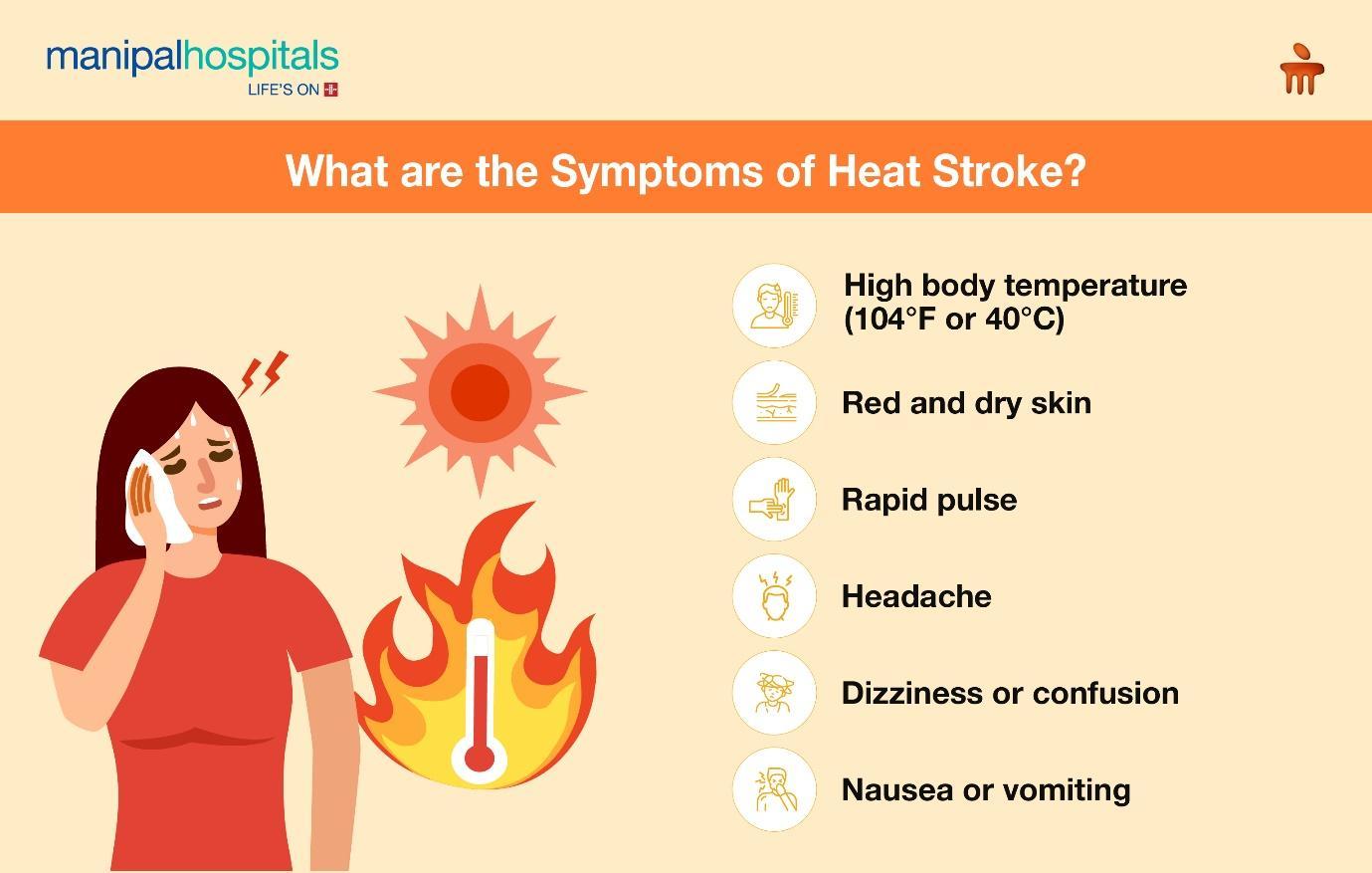
Summer can be fun, and long sunny days. But it also brings a serious health issue that many people overlook, which is heat stroke. This isn't just regular tiredness from the heat, it's a medical emergency. Knowing the signs of heat stroke and how to act quickly can save lives. Whether you're someone who loves being outdoors, works under the sun, or you’re caring for elders or children, this guide is for you. Let’s break down heat stroke and its symptoms in the simplest way possible to prevent it.
Synopsis
What is Heat Stroke?
Heat stroke happens when your body overheats to the point where it can't cool down on its own. Normally, we sweat to release heat. But during extreme heat or too much exertion under the sun, this system can fail. In this situation, the body temperature can rise above 104°F (40°C). That’s dangerous. It can cause serious harm to important organs like the brain, heart, kidneys, and muscles. If not treated immediately, heat stroke can lead to complications which at times may be life-threatening.

Heat Stroke Causes
Heat stroke happens when the body struggles to regulate its temperature and can't cool down effectively. Here are the most common causes that can lead to heat stroke, especially during summer:
-
Prolonged exposure to the high temperature: Spending too much time outdoors in the sun, especially during peak hours, which is from 10am to 4 pm can be a reason for the heat stroke. This cause your body temperature to rise dangerously high.
-
Heavy physical activity: Engaging in intense physical activities during hot and humid conditions can significantly increase the risk of developing heat stroke. Even exercising or working out in the heat can make your body produce more heat than it can release. This leads to overheating.
-
Wearing tight or heavy clothes: Especially fabrics that don’t allow the skin to breathe. When heat gets trapped and sweat can't evaporate, the body finds it hard to stay cool.
-
Dehydration: When you don’t drink enough water, your body can’t sweat properly. Sweating is how your body cools down, so dehydration increases the risk of heat stroke.
-
Underlying health conditions: Medical conditions like heart disease or diabetes can significantly increase the risk of heat stroke by impairing the body's ability to regulate temperature and respond to heat stress.
-
Alcohol or caffeine: This can lead to dehydration and interfere with your body’s natural cooling process. It may either reduce your ability to sweat or cause excessive fluid loss, both of which increase the risk of heat-related illnesses.
Signs of Heat Stroke to Watch Out For
We have listed some common sun stroke symptoms below that should raise a red flag. If someone shows these signs of heat stroke, don’t wait. Immediate action is crucial:
-
A dangerously high body temperature, typically over 104°F (40°C)
-
Skin that feels hot, appears red, and stays dry even in extreme heat
-
Rapid pulse
-
Dizziness or confusion
-
Muscle cramps or weakness
-
Unconsciousness or seizures in extreme cases
Heat Stroke vs. Heat Exhaustion: Know the Difference
|
Factor |
Heat Exhaustion |
Heat Stroke |
|
Temperature |
Normal or slightly elevated |
Very high (Above 104°F / 40°C) |
|
Skin Condition |
Cool, pale, and sweaty |
Hot, red, and dry (no sweating) |
|
Sweating |
Heavy sweating |
May stop sweating |
|
Pulse |
Fast but weak |
Rapid and strong |
|
Mental State |
Tiredness, dizziness, fainting |
Confusion, disorientation, loss of consciousness |
|
Muscle Condition |
Cramps or weakness |
Severe weakness or muscle breakdown |
|
Nausea/Vomiting |
May occur |
Often present |
What should we do in Case of Heat Stroke or Heat Exhaustion?
Immediate Heat Stroke Treatment
Act fast, it’s an emergency. If you think someone is experiencing heat stroke, here’s how you can help right away:
1. Get them out of the heat
Move them to a cooler area, such as indoors with a fan or AC, or at least into the shade or under a tree.
2. Cool them down quickly
Use anything available to bring their body temperature down:
-
Apply a wet cloth or sponge to their skin
-
Place ice packs on the neck, armpits, and groin
-
Apply ice packs to key areas like the neck, underarms, and groin
-
Mist them with cool water and fan gently
-
If possible, place them in a cold shower or bath
3. Hydrate, but only if they’re awake and alert
Give cool water with electrolytes if possible (Electrolyte water), and avoid sugary or alcoholic drinks. Avoid giving fluids if the person is unconscious or disoriented.
4. Call for medical help immediately
Even if they seem better after cooling down, they must be seen by a doctor. Heat stroke can cause serious damage if left untreated.
Heat Exhaustion Treatment
Heat exhaustion is the body’s early warning sign. Quick action can make recovery easier and prevent complications. Here’s what to do:
-
Move to a cool, shaded spot
-
Sip water or an electrolyte drink slowly
-
Loosen any tight or heavy clothing
-
Use a wet, cool cloth on the forehead and neck
-
Rest and avoid going back out in the sun for the rest of the day
The quicker you act, the easier it is to recover and avoid heat stroke altogether.
Who Is at Higher Risk?
Heat stroke can affect anyone, but certain people should be especially careful:
-
Elderly people, especially those who are living alone
-
Infants and young children
-
People with chronic illnesses
- Athletes or labourers working outdoors
-
Pets are at risk too!
-
Any age group in the particular area to experiencing a heat wave.
If you’re looking after someone in these groups, keep a close eye during the hot season.
Tips to Prevent Heat Stroke
A little care goes a long way in preventing heat-related illnesses. Here’s how:
-
Stay hydrated, drink water throughout the day, even if you’re not thirsty
-
Avoid outdoor activities during peak sun hours (11 am – 4 pm)
-
Wear light, loose-fitting clothes
-
Use sunscreen and a hat or umbrella
-
Take frequent breaks if you’re working outside
-
Keep your home cool, use fans, shades, or air conditioning
-
Never leave children or pets in parked cars, even for a few minutes
Conclusion
We often push ourselves through the heat, thinking it’s “just tiredness.” But heat stroke isn’t something to take lightly. If your body feels off, stop, rest, and cool down. It’s important to recognise the signs of heat stroke, act fast on it, and spread awareness. You’re not just protecting yourself, you’re helping others stay safe too. If you need any further assistance regarding heat stroke or heat exhaustion, you can book an appointment for a consultation with Dr. Dipankar Sarkar at Manipal Hospitals, Saltlake.
FAQ's
Yes, it can. If the indoor environment is poorly ventilated and extremely hot, especially during power cuts or heat waves. Elderly people and young children are especially at risk.
They sound similar but are very different. A stroke occurs due to a blockage or bleeding in the brain, while heat stroke is caused by the body overheating from prolonged exposure to high temperatures.
Watch out for confusion, hot, dry skin (even without sweating), a racing pulse, headache, and nausea. These are red flags don’t wait for someone to faint before taking action.
Heat exhaustion usually improves within a few hours if treated quickly. Heat stroke, however, can take days or even weeks depending on severity, and may need hospital care.
Yes. If not treated in time, it can affect vital organs like the brain, kidneys, or heart.
Children, older adults, people with chronic illnesses, labourers, and athletes are at higher risk during extreme summer heat.
Not exactly. While both involve fluid loss, heat exhaustion also affects how your body regulates temperature. So, apart from hydrating, cooling the body is just as important.





















 7 Min Read
7 Min Read


















